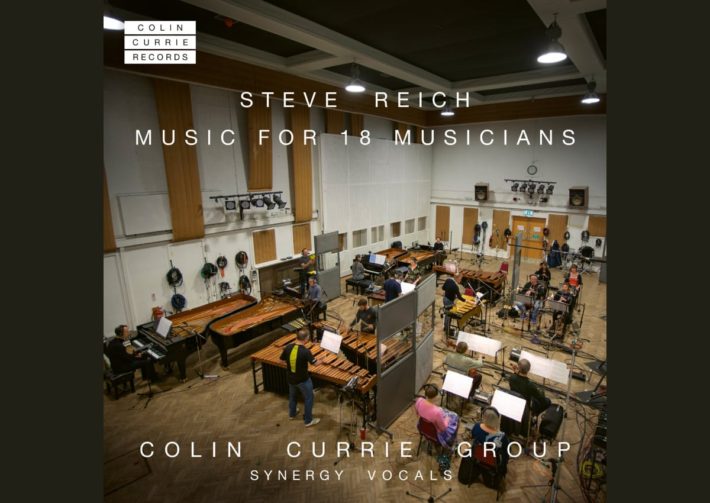Percussionist Colin Currie has gathered a group of his closest colleagues, including the Synergy Vocals ensemble, to present Steve Reich’s Music for 18 Musicians (1976). Reich’s own notes–which are thankfully included–are a must-read to understand the architecture of the work. His description makes it evident the level of precision implemented in the work’s construction and form. Though a summary does not do the level of detail enough justice, the piece is grounded upon the broad concepts of symmetry, arch, and pulse.
At nearly an hour long, Music for 18 Musicians presents challenges for performer and listener alike: for the former, it’s adjusting to changes while maintaining a fundamental consistency over the long haul. For the latter, it is an exercise in concentration: we find ourselves having to adjust to a very different soundscape devoid of more conventional structures. But as Currie alludes to in his notes, the music becomes an experience in and of itself—hypnotic, contemplative, and psychological.
The piece is divided into 11 sections, no arbitrary number given that the opening “Pulse” is based upon a progression of 11 chords. The ensemble does nice work in creating character differences within and across the shifting harmonies. For instance, the opening chord takes on a glowing, even optimistic personality; fast forward to 0’51” and the new chord has more hints of anticipation. The three-minute mark sees a minor tonality chord that shimmers at one point but, thanks to the bass clarinets, becomes orchestral the next. Another thing the performers pay good attention to is contour: the swells, ever-present, are satisfyingly full yet also precisely symmetrical each time they appear.
The performance makes it clear that minimalism doesn’t equate to one-dimensionality. There is an ongoing dynamic relationship present: the piano and mallet-based instruments approach their parts with an unfailing energy, but the vocal part adds a melodic and almost atmospheric quality. The Synergy vocalists have a lovely timbre and well-blended sound, all with an added touch of transparency that balances out the motoric patterns.
Related Classical Music Reviews
- Review: The American Project – Yuja Wang, Piano
- Review: Phrases – Héloïse Werner, Soprano
- Review: Aho – Double & Triple Concertos – Antwerp Symphony, Elts
Section I is where Reich starts to play with rhythmic relationships, with one of the marimbas branching off into a new pattern that is mimicked by the voices and strings. The vibraphone about a minute in is especially nice, its resonance cutting through the other textures to deliver refreshing accents. There are a lot of moving parts in Section II with new patterns and instrumental pairings, but it’s clear the musicians are at ease with one another. The vocal and marimba motifs are seamlessly interlocked and the recurring low winds swells, though persistent in character, never feel unwelcome.
What in fact makes the work a captivating listen despite its length is how Reich keeps deriving new sonorities at every turn; he does this through carefully calculated permutations of instrumental groupings. The ensemble uses these groupings to make contrasts between Section IV and V, for instance, stark. In IV, the clarinets, marimba, and vibraphone play with pristine clarity to create a lovely transparency. Fast forward to V and a much more robust character takes its place, thanks to the metronomic belches of the bass clarinets. Listen closely and you’ll also hear how the percussionists change their mallet approach on the marimbas so that what hits our ears first are the sharp mechanical strikes before the actual pitches.
Section IX gives the pianos their moment to shine, though just a little more sound balance in their favor would have been nice. The pairing of the winds and voices is a bit too loud but the sound itself is intriguing and somewhat unusual–perhaps reminiscent of a saxophone?
If there are any drawbacks to the performance, it would be aspects of the sound engineering. The marimbas could have been given more attention especially in their entrance, since they are integral in setting the tone of the work. The voices, for all the important textures they provide, also need more weight and presence throughout. But otherwise, for a work that requires excellent communication, synchronicity, and a steady hand and mind, the Colin Currie ensemble does a fine job. Throughout the performance, the musicians show an unfailing dedication and enthusiasm in tackling contemporary music and a demanding work.

Steve Reich – Music for 18 Musicians
Colin Currie Group
Synergy Vocals
Colin Currie Records, hybrid-SACD CCR0006
Related Albums
Read more classical music reviews or visit The Classic Review Amazon store
Follow Us and Comment:
[wd_hustle id=”HustlePostEmbed” type=”embedded”]











